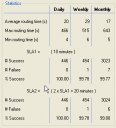Okay Admins, how many times have you been asked this question and what do you do to test it? Immediately drop everything that you’re doing and quickly send a couple of test emails in/out to your personal Internet email account and then take any necessary corrective action if required?
Whilst that works, wouldn’t it be way more efficient if you could proactively monitor Internet mail 24/7 and automatically raise alerts if there is a problem, plus also produce availability stats, and all from the comfort of your internal Notes environment? Now I fully realise that you cannot monitor every single email, but if you periodically send and monitor receipt of, a token message every few minutes, then that would certainly give you a nice warm indicative feel for exactly how Internet mail is performing and more importantly, flag potential issues before they become problems.
Well you can and quite easily, with the aid of a very useful third party commercial application called GSX Monitor, which is specifically written for Notes/Domino environments (there maybe other suitable applications). Amongst its many supervisory/reporting/alerting functions and capabilities, GSX Monitor can monitor server/network availability, database replication, Domino/BES/Sametime server tasks plus internal Notes mail routing. And it is this last item that we will focus on here, as it is provides all of our required core functionality, to which we simply need to add the ability to monitor external SMTP mail.
GSX Monitor monitors Mail Routing by regularly sending ‘coded’ emails to a nominated target email address and deposits them into the router mail.box of a source server. Notes then routes the message to its destination address in the normal way and after a pre-configured (SLA) time, GSX Monitor then checks the target’s mailbox for the relevant emails, where it logs the delivery times and then if the SLA criteria has been broken, can optionally raise an alert.
Alas things are not always that easy, even with commercial software, and one “limitation” of GSX Monitor, is that it requires a direct network connection (NRPC) to all of the Domino servers that it monitors. Furthermore, Notes attempts to route mail intelligently by its shortest path, which is kind of a problem when monitoring external Internet mail, as you would need two Domino servers, with different Internet Mail Domain addresses and external SMTP connectivity, in order to fully test both inbound and outbound Internet traffic.
My solution to this issue is really quite obvious and very easy to implement at little or no cost (apart of course from GSX Monitor!). . . Simply configure GSX Monitor to send its test emails out to an externally hosted POP/IMAP account, which is inturn, configured to auto-forward or redirect it, back to a nominated internal account, which GSX Monitor can then monitor as its target mailbox!
As for the POP/IMAP mail hosting, it is best if it supports auto-forward/redirection of the entire message and for this, I currently use and highly recommend, 1&1 Internet. Although in the past I’ve also successfully used bigfoot.com and I suspect that it might also work with GoogleMail (although I’ve not yet have the opportunity to test this).
The following diagram outlines the end-to-end process which will hopefully make more sense:

The following is an example of the Mail Routing stats that GSX Monitor automatically outputs:

Oh, one last thing. don’t forget to ensure that the address which GSX Monitor uses to send its emails, is enabled for sending Internet mail, and also that it is added to any SMTP Whitelists in your environment, in order to prevent the test messages falling fowl of any anti-spam/spoofing policies that your company may have implemented.


